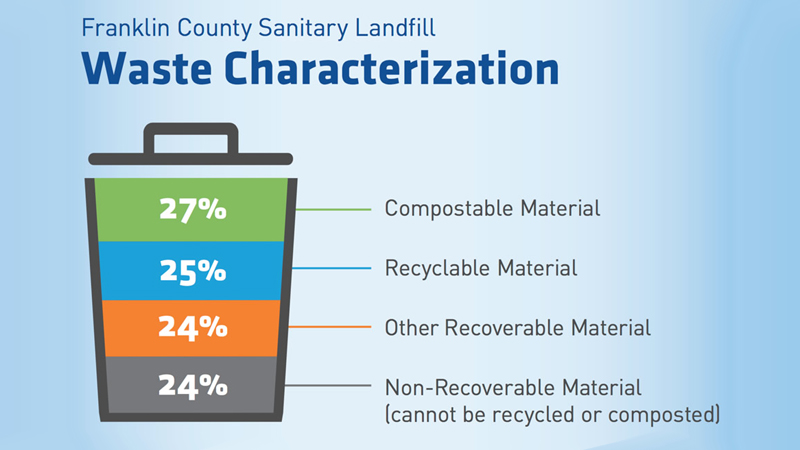The study also found that of those discarded materials, the items presenting the biggest opportunities for increasing diversion were food scraps (15% of discards or 115,835 tons) and corrugated cardboard (10% of discards or 77,220 tons). Other Compostable Items & Fiber represent 9% (61,780 tons).
“We weren’t surprised to learn that so much food was coming to the landfill, and we’re already at work helping to support rescuing edible food and redirecting it to families and individuals in need,” notes Kyle O’Keefe, SWACO’s director of innovation and programs. “We’re also working to increase opportunities for composting of inedible food and encouraging waste reduction practices to avoid the creation of waste in the first place.” When evaluating Franklin County’s potential to increase diversion based on the waste stream, the study found that of the 76% of the material currently landfilled, 41% could be diverted today through existing programs and an additional 35% has the potential to be diverted with new programs and infrastructure.
During the study period, 180 commercial and residential trash samples, weighing 39,000 pounds in total, were collected and analyzed. The materials were sorted into 64 categories and evaluated based on their weight, material type, and recyclability to determine what’s being thrown away and how much of it has the potential to be diverted from the landfill.
In November 2019, SWACO reported that Franklin County had reached a 50% diversion rate, one of the highest rates in the Midwest, yet the county still landfills over a million tons of waste every year. SWACO has set a goal to help residents and businesses in Franklin County divert 75% of their waste from the landfill. To reach the goal, SWACO is using data from the waste characterization study to make informed decisions regarding the creation of new programs aimed at increasing the diversion of a wide range of materials. For example, later this year, SWACO will launch new educational programs for capturing and recovering food waste, including funding drop-off composting sites in a number of Franklin County cities.
The study also assessed the value of the materials being landfilled and which are currently accepted for recycling through Franklin County’s curbside, drop-off, and other recycling programs (which include paper, cardboard, plastic bottles and jugs, glass bottles, metal cans). Those materials are estimated to have a market value of approximately $23 million.










